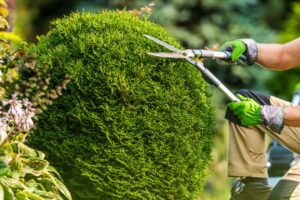Tree Trimming Round Rock is a crucial landscape maintenance service that keeps your trees healthy and looking their best. It also prevents damage to your home and reduces hazards.
When cutting large, heavy branches, it is essential to follow a three-step process to avoid tearing the bark. First, cut the underside of the branch. Then, move to the top side of the branch.

Removing dead branches during tree trimming reduces the risk of falling limbs, improves a landscape’s aesthetics, and helps support plant health. Dead limbs block the movement of nutrients throughout the canopy, creating conditions for disease and pest infiltration. Leaving them in place can also lead to structural problems that may require costly repair or removal.
It is important to recognize the difference between a dead and decaying branch and understand how to remove them during pruning properly. A good rule of thumb is that a branch should be considered dead if it has a dry exterior and brown inner color. If the branch is open or upright, it should be removed immediately. Otherwise, the branch will continue to decompose and could fall and cause damage.
If unsure whether a branch is dead, try scratching the bark with your fingernail. If the tissue is green underneath, it is still alive. Or press against the branch’s base and look for a swelling called a “branch collar.” The branch collar is an area of wood with a chemically protected zone. When a clean cut is made immediately outside the branch collar, hormones that close the wound are released and form a callus that prevents further decay (photo top left). However, this reaction can be disrupted by a jagged or stub cut. The resulting wound is more likely to be attacked by decay fungi and insects (photo bottom left).
Aside from dead branches, it is good practice to prune out crossing or rubbing limbs during trimming. These can become serious vectors for disease and eventually interfere with the growth of healthy branches.
Other pruning cuts can be made when all the necessary branches are removed. These include thinning, crown raising, and reduction. Thinning involves removing smaller branches from the outer portions of the crown to encourage new growth and reduce the size of the canopy to allow light and air in. Crown raising increases the clearance between trees, structures, vehicles, and pedestrians. Reduction reduces the height or spread of a tree, often for utility line clearance.
Tree trimming isn’t just about aesthetics; it helps promote healthy growth for a plant. When overgrowth occurs, it can limit sunlight exposure and hinder other parts of the plant’s development. It can also cause the plant to look scraggly and unbalanced. It can also prevent plants from accessing nutrients and moisture because they’re essential.
The main reason for trimming is to eliminate unhealthy, dead, or diseased branches that pose a safety risk for people and property. This is especially important for taller trees, where the branches can become in the way of paths, driveways, or buildings. It’s also a good idea to trim trees before they grow close to power lines or block views of your home.
Other reasons for trimming can include getting rid of overgrown limbs or reshaping an entire tree. This includes techniques such as thinning the crown, which removes specific live branches to reduce the overall density of the canopy and increase air circulation. It can also help reduce stress on certain limbs from gravity, wind, snow, or ice.
Lastly, it’s often gettingnches that are causing structural damage. This can often be necessary, including removing crossing or rubbing limbs, which can weaken the structure of a tree. It’s also a good idea for homeowners to watch for signs of damage, like holes or cracks in the bark or wood.
While it’s common to see these symptoms in older trees, it’s important to have them inspected regularly by a professional. When these problems are detected early, they’re easier to address and less likely to impact the health of a tree.
Another thing to note is that there are different times of the year to conduct tree trimming. This is because some trees require a more vigorous pruning process than others. This is especially true of oak trees, which can be prone to disease and insect infestations. Generally, it’s best to prune these trees in the fall or winter. This will allow them to heal before the stressors of summer and spring — such as insects and diseases — start to appear.
During tree trimming, it’s important to be sure that you’re removing stubborn branches. This includes branches that are growing in the wrong direction, crossing other trees, or causing damage to their bark. It also means removing dead or dying branches, as well as removing diseased or insect-infested limbs. The goal is to keep your trees healthy and safe for everyone who uses them.
This can be done for various reasons, including improving the appearance of your yard and home, increasing sunlight penetration, encouraging flower or fruit production, or simply reducing stress on the tree due to heavy branches or winds. It can also be done to reduce the risk of storm-related damage and help prevent obstructions of electrical or phone lines.
When pruning small twigs or branches, cutting them back to an intersecting branch or vigorous bud is best. This can help promote strong growth and prevent future problems like suckers. When pruning larger limbs, it’s important to make three cuts. This allows the tree to heal over the wounds more easily and also reduces the risk of stripping bark from the trunk. The first cut should not be full but rather a notch on the underside of the branch. This helps preserve the branch collar, a swollen tissue area where the branch meets the trunk or parent limb.
The second cut should be made from the top downward several inches farther out than the first. This removes most of the weight from the branch and makes it easier for a third cut to be made that removes the stub. It’s also important not to leave too long of a stub, as this can cause the tree to form an improper callus around the wound and inhibit its healing process.
It’s also a good idea to remove suckers, which are weak and weedy-looking branches that can form near the base of the trunk. These will never grow into desirable branches and only steal energy from the tree that it could have used to promote stronger, healthier growth.
When storms damage trees, pruning is often recommended to remove limbs that broke off. This can help reduce the chance of those branches falling on houses, cars, or people. Removing these jagged branches can also prevent damage to the tree when it grows back and helps it heal more quickly.
When trimming these limbs, it is important to ensure the cuts are done correctly. Pruning wounds that aren’t cleaned properly can lead to disease and pest problems. It is important to use sharp tools so that the cuts are clean and don’t leave stubs. This will also help ensure that the wounds callus over quickly, reducing the risk of rot or insect infestation.
The best time to prune a tree is usually in the winter. Most trees are dormant during this period, making identifying dead or unhealthy limbs easier. Additionally, pruning during this time can encourage new growth as soon as the weather warms up.
Several different types of pruning cuts can be used to remove damaged limbs. The most common is the thinning cut, which involves removing some of the outermost branches or twigs from a branch. This type of pruning can help promote healthier growth and can also remove some of the competition between branches for sunlight and resources.
Another type of pruning that can remove damaged limbs is the crown cleaning cut, which involves removing some smaller branches from a larger branch. This type of pruning can be used to remove suckers, which can sometimes grow from the base of a larger branch and compete with other branches for resources and light.
Finally, the final type of pruning used to remove damage from a tree is the structural removal cut. This is a very difficult and dangerous procedure that should only be performed by a certified arborist. This is a very risky procedure that can be used to remove a tree’s broken or damaged parts and should only be done when necessary for safety reasons.
